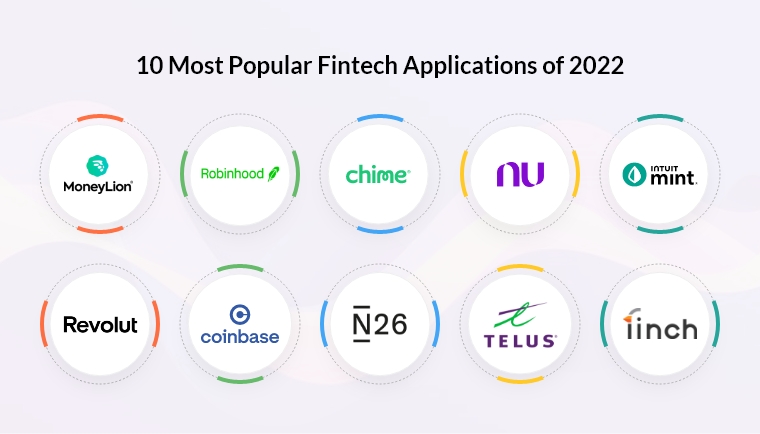
Have you ever wondered if finances were always handled in such a seamless and hassle-free way as they are now? How did we enter the era of quick online payments and convenient at-home transactions? All the credit goes to Fintech applications referring to Financial Technology that revolves around making financial transactions and services easier in the current times.
These are used by businesses to aid automation. Fintech Business models come around in many ways and means without even coming to our notice. The various types include Digital Lending, Payment, Blockchain, Digital Wealth Management, and more. These primary categories further have a multitude of sub-categorical areas.
Considering this, if you’re seeking to develop a secure Fintech application, we’ve covered everything you need to know in detail. However, let’s shed some light on how Fintech differs from banks before we proceed with the same.
Table of Contents
How does fintech differ from banks?
A question that pops up in your head when you think of anything remotely related to finances is, “How different is this concept from a regular bank?”. There is a distinctive difference between the functioning of a normal bank and a fintech. While every financial institution stands regulated, fintech is more flexible than its stricter counterparts – banks.
The fact that fintech doesn’t single out from just one regulator has given birth to a wide array of fintech in the past decade. But fintech is constantly giving out tools to banks that are making them not just more efficient in the context of a better customer experience and preventing major fraud.
Risks and challenges associated with fintech applications
1. Data security
Data security continues to be a major concern across all walks of life. Providing a secure gateway in the virtual space is much more complex than a regular bank equipped with measures such as highly guarded vaults, CCTVs, etc. Vulnerabilities are usually hidden until they expand into something potentially dangerous; by then, it is too late.
2. Government regulations
Despite trying their best, fintech companies find it almost impossible to avoid government restrictions and regulations. This interference exists at all levels.
3. AI integration
The use of AI changes the ballgame for the better, but the building up of AI-supported systems and their further maintenance is very complicated.
4. Blockchain integration
Blockchain integration paves the way for a more efficient path for data exchange.
5. Personalized service
The level of personalization that regular banks offer is something customers appreciate and are willing to see even in online modes. Personalization gives the customer more options, eventually making decision-making more impactful.
10 Most Popular Fintech Applications of 2022
- MoneyLion
- Robinhood
- Chime
- Nubank
- Mint
- Revolut
- Coinbase
- N26
- Tellus
- Finch

7 Fintech cybersecurity solutions to consider while developing an application
Fintech apps make most of their money through the display of commercials. The app owner gets paid by some third-party ad network. Money is also earned anytime a user clicks on the ads. Let’s see a few vital Fintech solutions to keep in mind to develop a secure application.
1. Data encryption
Encryption is the method of security that makes information encoded and unreadable until some special keys are introduced. Some algorithms that you can use to encrypt your data are:
- RSA – Equipped with public and private encryption keys
- TwoFish – Encrypts data into 128-bit blocks
- 3DES – Data is ciphered three times on a loop
Another method that works on a similar principle is tokenization. Instead of encrypting data into an unreadable format, it provides your data with a unique key. These tokens are stored in token vaults, and to make these token vaults even safer, you can always encrypt them.
2. Role-based access control
Role-Based Access Control shifts your access level based on your relationship with a particular organization. You can have roles like IT Specialist, Customer, Manager, etc., and would be denied access beyond your reach within the organization. This feature significantly reduces threats, both internal and external.
While building your fintech application, choosing the right software development company with the right level of expertise is imperative to meet all your needs. The appropriate technology stack and background are essential.
3. Secure authentication technologies
To protect your fintech application from targeted internal and external security threats, make use of the following:
- OTP system:
One-time passwords work as extra layers of protection. An added credential in the form of a unique, spontaneously generated pin makes the whole process much safer. - Password change:
Password compromise accounts for 80% of all security breaches. You can steer past these security threats by forcing a regular password change. Something on the lines of a mandatory change of password once every ⅞ months is your way to go. - Monitoring:
Unauthorized logins are the most prominent way to spot loopholes in the security system. Regular monitoring can help bridge this very gap. You can introduce the feature of blocking an account post four or five failed login attempts. - Time of login sessions:
Keeping the login sessions timed ensures less time for a potential hacker to acquire data from an account. - Adaptive authentication:
Adaptive authentication is an attribute and consequence of constant monitoring. Adaptive authentication studies the user’s behavior, such as failed login attempts, and adds layers of protection if needed.
4 .DevSecOps
In collaboration with the ongoing cybersecurity trends, Software Development Life Cycle makes a fintech application well protected. DevSecOps makes the whole process of making a secure fintech application a lot easier. Cybersecurity becomes the core element of this concept, along with other important aspects like testing phases.
5. Testing
The number of times you test a fintech application prototype while still in the development phase is large. How can you make this more secure?? We’ve got you covered here also:
- Professional security team:
You need engineers and managers who are invested deeply in the process and can develop code differentiations about real-time data breaches and threats. You can make use of fintech security teams that vendors often outsource. These people test your application without compromising on security. - Penetration tests:
Penetration attacks are harmless, self-generated security breaches directed toward your application. This makes you more aware of possible future loopholes and how to eliminate them in no time. - IT security audit:
A security audit runs on the same lines as penetration tests but is far more complex and reveals bigger problems that might be hurdles along the way. The most significant use of a security audit is that it uncovers major technological flaws.
6. Writing a secure code
- Deny by default:
Deny access to all of the app’s functions. Let it be accessible based on need. - Framework messages:
Pay attention to coding tools that automatically notify you about any potential shortcomings in your code. - Avoid broken access control:
Implementing an access control policy is crucial. Ensure you note the insecure IDs, client-side control, and the like. - SQL injection:
Protecting your app against SQL injection hacking attacks can be done using the above-mentioned penetration attack technique.
7. Infrastructural security
- Perimeter defense:
This particular layer deals with proxy servers and firewalls. Furthermore, a proper router configuration will aid in preventing internal attacks also. - Maintenance of operating systems:
This layer can be improved by periodically updating the system. You can use tools like Microsoft’s Software Update Service for the same. - Third-party components:
Look into the management of third-party components as early as possible because an incorporated third-party component needs constant monitoring. This includes getting the new version, alerts about vulnerabilities, fixing these vulnerabilities, etc. - Failover redundant infrastructure:
Implement high availability for your application structure to minimize downtime. Equip each layer of technology for redundancy. This high redundancy and availability depend on factors like environment, hardware, software, network, and data. While building the infrastructure, ensure that each component can handle failovers separately. - Use HTTPS and protect your server:
Use an HTTPS SSL certificate for maximum security regarding the data submitted by your users. A server is the first point of contact with the outside world, so it naturally becomes one of the most attacked layers of any application. Store web files on different drives to enhance the security of your server, and you might also want to use CSP – Content Security Policy to prevent attacks like XSS – Cross Site Scripting. - Use VPN:
VPN allows you to build a secure network using public internet lines. As much as this initial setup might look a little complex, it would do you wonders in the case of a security breach.
fintech app?
Our fintech app consultant will guide you and send you a
customized quote based on your needs
Bottom line
Fintech applications are the topic of discussion everywhere. With the pandemic and even the technology-dependent era, we’re all entering, handling finances online is everyone’s primary preference. Fintech applications make log keeping easier for the user, transactions are more effortless, and gateways are more secure if developed. So if you’re on the path of coming up with a fintech application, now is the right time.
Here are some other things to keep in mind while developing a fintech application:
- Secure data transmission
- Payment blocking
- Quality assurance
- Having a trustworthy vendor
- Addition of specific features that are unique to your application
- Recruiting a highly competent security team
- Cloud migration
- Leaving margin for human errors
- Building a secure architecture





